Bosnia and Herzegovina
the last decade
 End of the final decade of the 20th century is a logical moment in which
we are to make review and analysis of the previous period. Especially if
we are talking about Bosnia and Herzegovina (and former Yugoslavia),
considering the activities that took place during the last decade. It
would be too much to expect this text to provide a detailed and overall
analysis of the last 10 years - at this moment I do not have time or
available historic information to do that, and my memory is not vital
enough to remind me of some things.
End of the final decade of the 20th century is a logical moment in which
we are to make review and analysis of the previous period. Especially if
we are talking about Bosnia and Herzegovina (and former Yugoslavia),
considering the activities that took place during the last decade. It
would be too much to expect this text to provide a detailed and overall
analysis of the last 10 years - at this moment I do not have time or
available historic information to do that, and my memory is not vital
enough to remind me of some things.
Still this is the chronology of events that were important in the period
of 1990 - 1999.
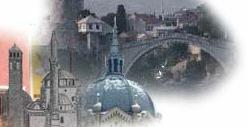 In 1990. SFR Yugoslavia (and Bosnia with it) took part in democratic
changes that had taken over the so-called East block. First elections
were scheduled for November of that year (after they had already
happened in Slovenia and Croatia).
In 1990. SFR Yugoslavia (and Bosnia with it) took part in democratic
changes that had taken over the so-called East block. First elections
were scheduled for November of that year (after they had already
happened in Slovenia and Croatia).
Posters of SDA (Party of Democratic Action), which was muslim at the
time (current Bosniaks), appeared in Sarajevo during the summer of 1990
and they announced the upcoming political pluralism. SDA was formed by
ex prisoners from the eighties, lead by Alija Izetbegovi} who was
accused of spreading islam fundamentalism. After SDA, HDZ (Croat
Democratic Union) and SDS (Serb Democratic Party) were formed in Bosnia.
These parties were already existing in Croatia. Apart from them there
were several other more or less civil/national parties.
1990 was the time of national awakening. According to that, the election
results demonstrated conscience level of Bosnian voters. Liberal and
civil Reformists, Socialists and those like them were heavily defeated
by three national parties. Still, the year 1990 was quite good, thanks
to the economic reforms of Ante Markovi}. Most of the people at the time
did not worry about a bad political situation.
1991. brought national division among Bosnian people. Members of the
three nations are closing themselves into national groups, listening to
the war sounds coming from Slovenia and Croatia with inevitable
"screaming" against each other. Flags were waving and threatning with
war and arms. In the summer of 1991 started an unofficial aggression on
Bosnia nad Herzegovina. In August JNA (Yugoslav National Army) destroyed
a village Ravno in Southeast Herzegovina. BiH became a terrain for
confrontations that were coming from Croatia. At the same time, BiH was
being filled with JNA soldiers withdrawing from Croatia and Slovenia.
Para-military formations were forming, mostly with the approval of the
three national parties. Sporadic conflicts, hostility and tensions
became very intensive among the people. Also, there was a dilemma
concerning the future of the Republic - independence or staying in
Yugoslavia.
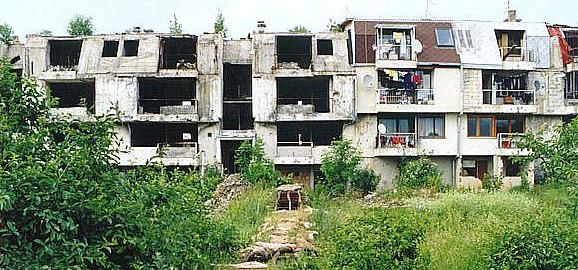 SDS organized a referendum at the beginning of 1992, which would decide
on staying of Bosnia and Herzegovina within Yugoslavia. Referendum was a
big success with incredible 113% of votes. No one explained how it was
possible. Republic Assembly made another referendum at the end of
February, and the decision was made about the independence of Bosnia and
Herzegovina. There were enough votes and Bosnia made its first step
toward independence.
SDS organized a referendum at the beginning of 1992, which would decide
on staying of Bosnia and Herzegovina within Yugoslavia. Referendum was a
big success with incredible 113% of votes. No one explained how it was
possible. Republic Assembly made another referendum at the end of
February, and the decision was made about the independence of Bosnia and
Herzegovina. There were enough votes and Bosnia made its first step
toward independence.
The first weekend in March came with barricades in Sarajevo. The town
was blocked by armed activists of SDS. Military formations under SDA
made counter barricades. Thirty hours later, the citizens of Dobrinja
were moving to the centre of the town breaking the barricades on the
way. More Sarajevo people joined them in this. The town was united
again. And fear was increasing. The war was obvious but the time of its
beginning was not. And that was very upseting.
At the beginning of April, while Bosnia was being recognized as an
independent state, Sarajevo got new barricades. Citizens of Dobrinja
were on their way to the centre as before, but this time the
consequences were tragic. First civil victims fell in Vrbanja bridge, in
the centre of the city. The war officially started. SDS snipers were
shooting at the people standing in front of the Assembly building the
next day. From the inside areas of the country came news about material
destructions and crimes against civilians.
SDS founded Serb Republic Bosnia and Herzegovina, and later Republika
Srpska (as an independent state) on the territory with Serb majority.
HDZ had already founded Herzeg Bosnia.
At the same time, the number of countries recognizing Bosnia and
Herzegovina was rising. Also rising was the number of victims.
Three bloody years were coming.
News from Bosnia were mostly the same - the starved, refugees, the
killed, the raped, humanitarian aid, war crimes, concentration camps,
genocide...
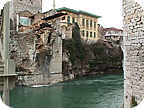 The year 1993 complicated the war situation in Bosnia. There was a
confrontation of Bosnian Army (Bosniak majority) and HVO - Croat Defence
Council (Croat majority). Also, at the Northwest , Fikret Abdic (ex SDA)
formed an Autonomous district West Krajina, because of his disputes with
Sarajevo authorities. The war got its fourth party in the conflict
(excluding world power). The news were still the same - refugees, raped,
humanitarian aid, genocide... but this time much more intensive.
Sometimes there were UN resolutions that nobody would respect...
Life and death games were still playing in Bosnia and Herzegovina.
Outside the country, different sessions that were including
representatives of all three nations were taking place. The first time
the question was the division and exchange of territories. Although this
is denied (especially by Bosniak leadership).
The year 1993 complicated the war situation in Bosnia. There was a
confrontation of Bosnian Army (Bosniak majority) and HVO - Croat Defence
Council (Croat majority). Also, at the Northwest , Fikret Abdic (ex SDA)
formed an Autonomous district West Krajina, because of his disputes with
Sarajevo authorities. The war got its fourth party in the conflict
(excluding world power). The news were still the same - refugees, raped,
humanitarian aid, genocide... but this time much more intensive.
Sometimes there were UN resolutions that nobody would respect...
Life and death games were still playing in Bosnia and Herzegovina.
Outside the country, different sessions that were including
representatives of all three nations were taking place. The first time
the question was the division and exchange of territories. Although this
is denied (especially by Bosniak leadership).
 The year is 1994. News mostly the same - refugees, killed, camps,
genocide... International diplomacy helped to stop conflicts of Bosnian
Army and HVO. But the hate and the consequences of crimes were still
present. Very soon, the representatives of Croat and Bosniak people will
have signed an agreement in Washington - the forming of Federation
BiH.This is how they will make first sketches of the future political
(entity) division of Bosnia and Herzegovina. The world had a lot of news
about the siege of Sarajevo, Gorazde, Bihac, Zepa, Srebrenica... made by
Republika Srpska Army (a few years later, there will be many news about
the treatment that Bosnian Army had for the minority people during the
same siege.). Military intervention was mentioned many times but was not
happening. There were just some small strikes on RS tenks around
Gorazde.
The year is 1994. News mostly the same - refugees, killed, camps,
genocide... International diplomacy helped to stop conflicts of Bosnian
Army and HVO. But the hate and the consequences of crimes were still
present. Very soon, the representatives of Croat and Bosniak people will
have signed an agreement in Washington - the forming of Federation
BiH.This is how they will make first sketches of the future political
(entity) division of Bosnia and Herzegovina. The world had a lot of news
about the siege of Sarajevo, Gorazde, Bihac, Zepa, Srebrenica... made by
Republika Srpska Army (a few years later, there will be many news about
the treatment that Bosnian Army had for the minority people during the
same siege.). Military intervention was mentioned many times but was not
happening. There were just some small strikes on RS tenks around
Gorazde.
1995.
Fourth year of the war. News were the same - refugees, killed, camps,
genocide... And often there were massacres. The crucial year of the war.
The bloodiest. The summer brought a new attempt to free Sarajevo, the
fall of Srebrenica and Zepa. Thousands of dead people. NATO began a
military intervention with military resources of RS Army as targets. The
RS Army was quite destabilized after that. The last but the most
intensive moments of the war were still going on.
In November, representatives of the three people and three parties
(Izetbegovic, Krajisnik, Jelavic) with Milosevic and Tudjman, signed the
Dayton agreement. There was a graffiti in Sarajevo "Fuck Dayton, Laibach
has a concert". It was in the night of the signing.
They all came back from Dayton to Bosnia and Herzegovina as absolute
winners. Bosnia and Herzegovina finally got peace (at least on the
paper). Implementation of the agreement was the next step. Territorial
changes, migrations, taking the dead out of their graves and moving of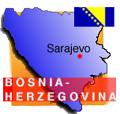 the bones. Radovan Karadzic, leader of Bosnian Serbs at the time and one
of the synonims for Bosnian wall, and Ratko Mladic, general of the Army
at the time, were totally marginalized, because of the compromise with
the International Community. Their opponents (SDA, HDZ) remained in
their old positions.
the bones. Radovan Karadzic, leader of Bosnian Serbs at the time and one
of the synonims for Bosnian wall, and Ratko Mladic, general of the Army
at the time, were totally marginalized, because of the compromise with
the International Community. Their opponents (SDA, HDZ) remained in
their old positions.
The year 1996. found country in peace but completely destroyed. The
second elections took place in September. The result was very much the
same as before. Time for the true democratic and multi-party system was
still not mature enough. At least that was what SDA,HDZ and SDS thought,
breaking and stealing human and political rights of the minorities in
various ways. Thanks to the international donations and credits, the
reconstruction began, mostly in the Federation. Because of the radical
politics of the leadership at the time, Republika Srpska had to wait for
a year or two.
Further development of Bosnia and Herzegovina is well-known.
In 1997. and 1998. there were new elections which managed to change the
country's political structure. Mostly thanks to the OSCE and its
election commisson and rules that managed to reduce the breaking of
human and political rights to the minimum. Sometimes it was not very
successful. The reconstruction of the country and interhuman relations
began.
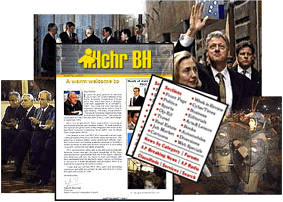 Today we are beginning to see things that were happening in the area
during the war. Especially the crimes. And than the crime and everything
else that the war had to offer to the war dogs. Economic situation, if
we were to trust the reports, is getting better, but it is mostly
happening in the measure in which the progress is inevitable.
The process of privatization will destroy everything that was not
destroyed in the war. Only individuals from the government will benefit
from it.
Today we are beginning to see things that were happening in the area
during the war. Especially the crimes. And than the crime and everything
else that the war had to offer to the war dogs. Economic situation, if
we were to trust the reports, is getting better, but it is mostly
happening in the measure in which the progress is inevitable.
The process of privatization will destroy everything that was not
destroyed in the war. Only individuals from the government will benefit
from it.
 Human rights finally became something more than just a phrase on the
paper to be used for international visitors. But the situation is still
not very good.
Human rights finally became something more than just a phrase on the
paper to be used for international visitors. But the situation is still
not very good.
The process of centralization of state institutions declared by the
Dayton agreement is getting bigger. BiH Federation and Republika Srpska
and their political representatives are beginning to act as one state
which is in opposition to the entities that would like to be countries
for themselves.
Governmental structures are still trying to make the work of independent
media difficult, because they are aware of the fact that these media are
the greatest threat for them because they are telling the truth. That is
just one of the reasons why Bosnia will not be accepted into the
European Council so soon. This also has to do with the human rights that
we already mentioned.
The political situation seems to be more liberal. It is also possible to
expect that the opposition lead by SDP will take over the majority of
votes from the national parties in the elections scheduled for the April
2000. Reality or not, that is for the Bosnian voters to decide.
And for the new millennium.
In only 10 years time, Bosnia and Herzegovina managed to move from the
developing country to a totally ruined country which almost does not
exist. Will the people who live in it with such an intensity continue to
live in the upcoming decade/millennium...?
It remains to be seen.
 In 1990. SFR Yugoslavia (and Bosnia with it) took part in democratic
changes that had taken over the so-called East block. First elections
were scheduled for November of that year (after they had already
happened in Slovenia and Croatia).
In 1990. SFR Yugoslavia (and Bosnia with it) took part in democratic
changes that had taken over the so-called East block. First elections
were scheduled for November of that year (after they had already
happened in Slovenia and Croatia). End of the final decade of the 20th century is a logical moment in which
we are to make review and analysis of the previous period. Especially if
we are talking about Bosnia and Herzegovina (and former Yugoslavia),
considering the activities that took place during the last decade. It
would be too much to expect this text to provide a detailed and overall
analysis of the last 10 years - at this moment I do not have time or
available historic information to do that, and my memory is not vital
enough to remind me of some things.
End of the final decade of the 20th century is a logical moment in which
we are to make review and analysis of the previous period. Especially if
we are talking about Bosnia and Herzegovina (and former Yugoslavia),
considering the activities that took place during the last decade. It
would be too much to expect this text to provide a detailed and overall
analysis of the last 10 years - at this moment I do not have time or
available historic information to do that, and my memory is not vital
enough to remind me of some things. SDS organized a referendum at the beginning of 1992, which would decide
on staying of Bosnia and Herzegovina within Yugoslavia. Referendum was a
big success with incredible 113% of votes. No one explained how it was
possible. Republic Assembly made another referendum at the end of
February, and the decision was made about the independence of Bosnia and
Herzegovina. There were enough votes and Bosnia made its first step
toward independence.
SDS organized a referendum at the beginning of 1992, which would decide
on staying of Bosnia and Herzegovina within Yugoslavia. Referendum was a
big success with incredible 113% of votes. No one explained how it was
possible. Republic Assembly made another referendum at the end of
February, and the decision was made about the independence of Bosnia and
Herzegovina. There were enough votes and Bosnia made its first step
toward independence. The year 1993 complicated the war situation in Bosnia. There was a
confrontation of Bosnian Army (Bosniak majority) and HVO - Croat Defence
Council (Croat majority). Also, at the Northwest , Fikret Abdic (ex SDA)
formed an Autonomous district West Krajina, because of his disputes with
Sarajevo authorities. The war got its fourth party in the conflict
(excluding world power). The news were still the same - refugees, raped,
humanitarian aid, genocide... but this time much more intensive.
Sometimes there were UN resolutions that nobody would respect...
Life and death games were still playing in Bosnia and Herzegovina.
Outside the country, different sessions that were including
representatives of all three nations were taking place. The first time
the question was the division and exchange of territories. Although this
is denied (especially by Bosniak leadership).
The year 1993 complicated the war situation in Bosnia. There was a
confrontation of Bosnian Army (Bosniak majority) and HVO - Croat Defence
Council (Croat majority). Also, at the Northwest , Fikret Abdic (ex SDA)
formed an Autonomous district West Krajina, because of his disputes with
Sarajevo authorities. The war got its fourth party in the conflict
(excluding world power). The news were still the same - refugees, raped,
humanitarian aid, genocide... but this time much more intensive.
Sometimes there were UN resolutions that nobody would respect...
Life and death games were still playing in Bosnia and Herzegovina.
Outside the country, different sessions that were including
representatives of all three nations were taking place. The first time
the question was the division and exchange of territories. Although this
is denied (especially by Bosniak leadership).
 The year is 1994. News mostly the same - refugees, killed, camps,
genocide... International diplomacy helped to stop conflicts of Bosnian
Army and HVO. But the hate and the consequences of crimes were still
present. Very soon, the representatives of Croat and Bosniak people will
have signed an agreement in Washington - the forming of Federation
BiH.This is how they will make first sketches of the future political
(entity) division of Bosnia and Herzegovina. The world had a lot of news
about the siege of Sarajevo, Gorazde, Bihac, Zepa, Srebrenica... made by
Republika Srpska Army (a few years later, there will be many news about
the treatment that Bosnian Army had for the minority people during the
same siege.). Military intervention was mentioned many times but was not
happening. There were just some small strikes on RS tenks around
Gorazde.
The year is 1994. News mostly the same - refugees, killed, camps,
genocide... International diplomacy helped to stop conflicts of Bosnian
Army and HVO. But the hate and the consequences of crimes were still
present. Very soon, the representatives of Croat and Bosniak people will
have signed an agreement in Washington - the forming of Federation
BiH.This is how they will make first sketches of the future political
(entity) division of Bosnia and Herzegovina. The world had a lot of news
about the siege of Sarajevo, Gorazde, Bihac, Zepa, Srebrenica... made by
Republika Srpska Army (a few years later, there will be many news about
the treatment that Bosnian Army had for the minority people during the
same siege.). Military intervention was mentioned many times but was not
happening. There were just some small strikes on RS tenks around
Gorazde. the bones. Radovan Karadzic, leader of Bosnian Serbs at the time and one
of the synonims for Bosnian wall, and Ratko Mladic, general of the Army
at the time, were totally marginalized, because of the compromise with
the International Community. Their opponents (SDA, HDZ) remained in
their old positions.
the bones. Radovan Karadzic, leader of Bosnian Serbs at the time and one
of the synonims for Bosnian wall, and Ratko Mladic, general of the Army
at the time, were totally marginalized, because of the compromise with
the International Community. Their opponents (SDA, HDZ) remained in
their old positions. Today we are beginning to see things that were happening in the area
during the war. Especially the crimes. And than the crime and everything
else that the war had to offer to the war dogs. Economic situation, if
we were to trust the reports, is getting better, but it is mostly
happening in the measure in which the progress is inevitable.
The process of privatization will destroy everything that was not
destroyed in the war. Only individuals from the government will benefit
from it.
Today we are beginning to see things that were happening in the area
during the war. Especially the crimes. And than the crime and everything
else that the war had to offer to the war dogs. Economic situation, if
we were to trust the reports, is getting better, but it is mostly
happening in the measure in which the progress is inevitable.
The process of privatization will destroy everything that was not
destroyed in the war. Only individuals from the government will benefit
from it. Human rights finally became something more than just a phrase on the
paper to be used for international visitors. But the situation is still
not very good.
Human rights finally became something more than just a phrase on the
paper to be used for international visitors. But the situation is still
not very good.